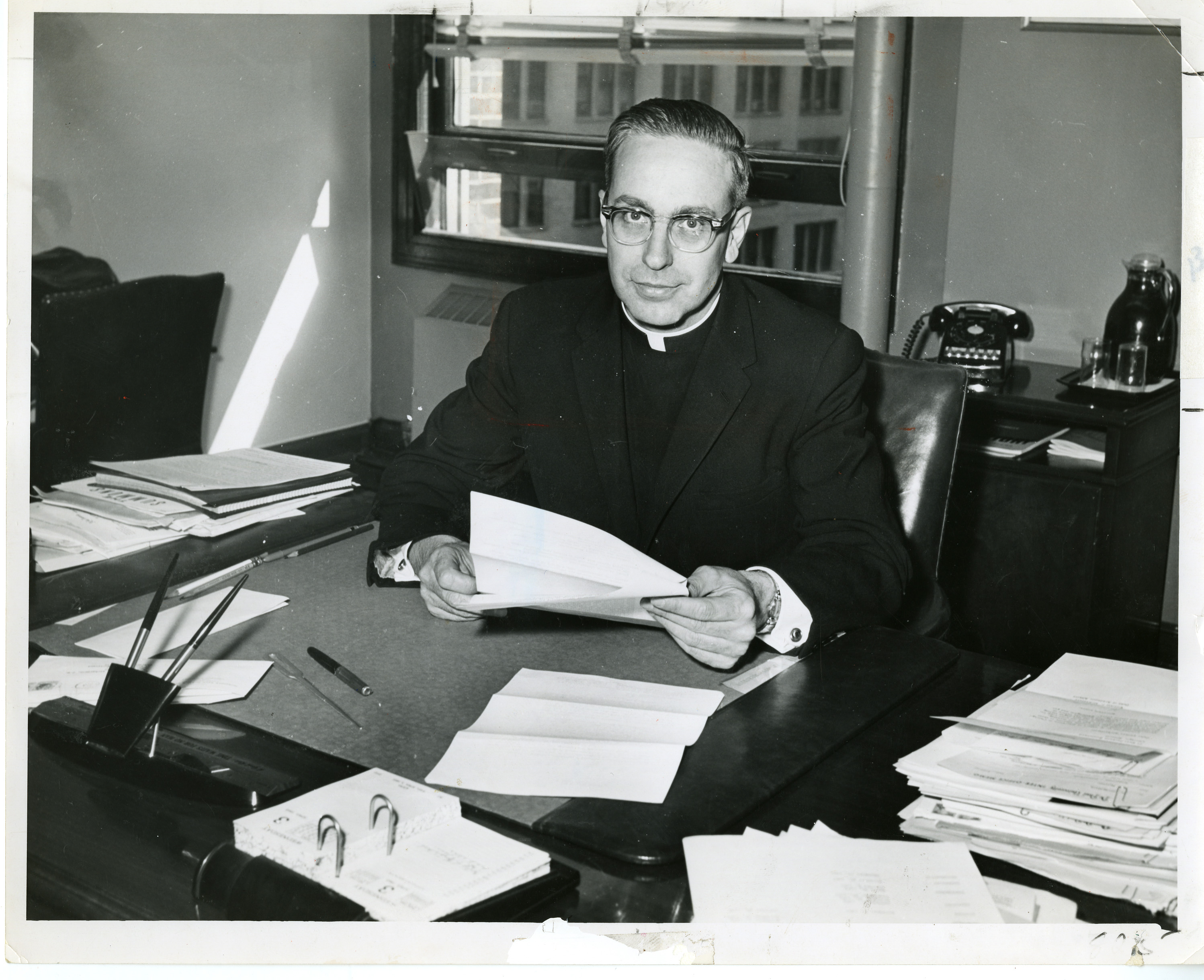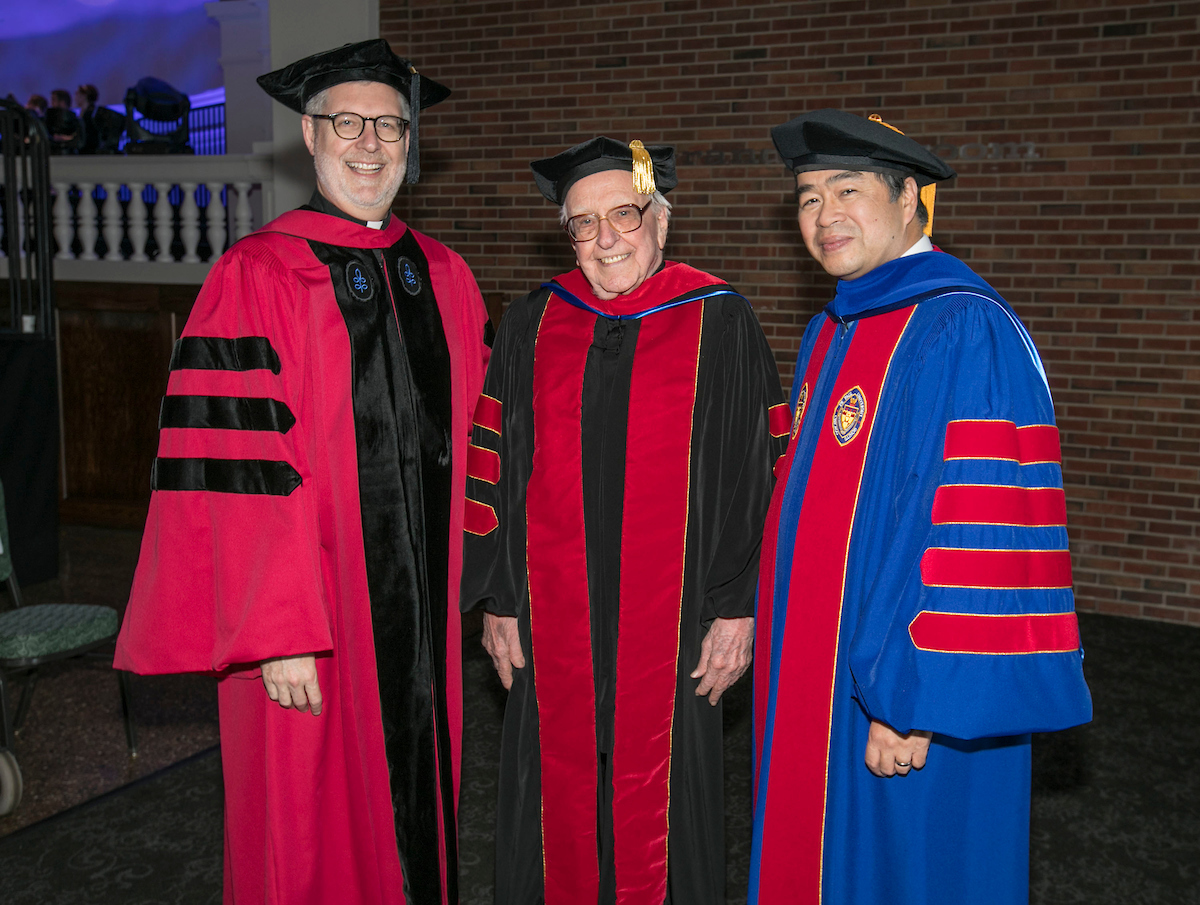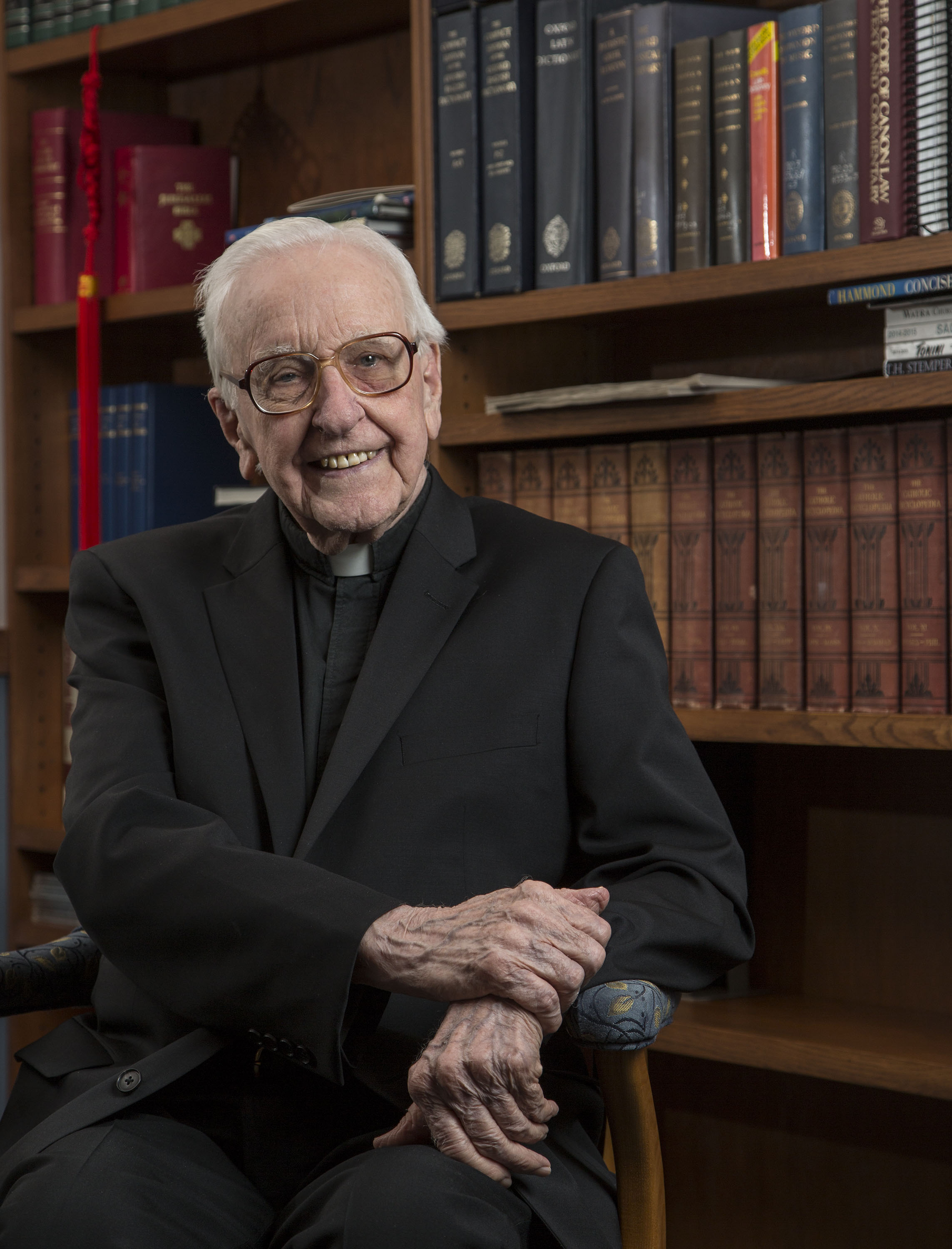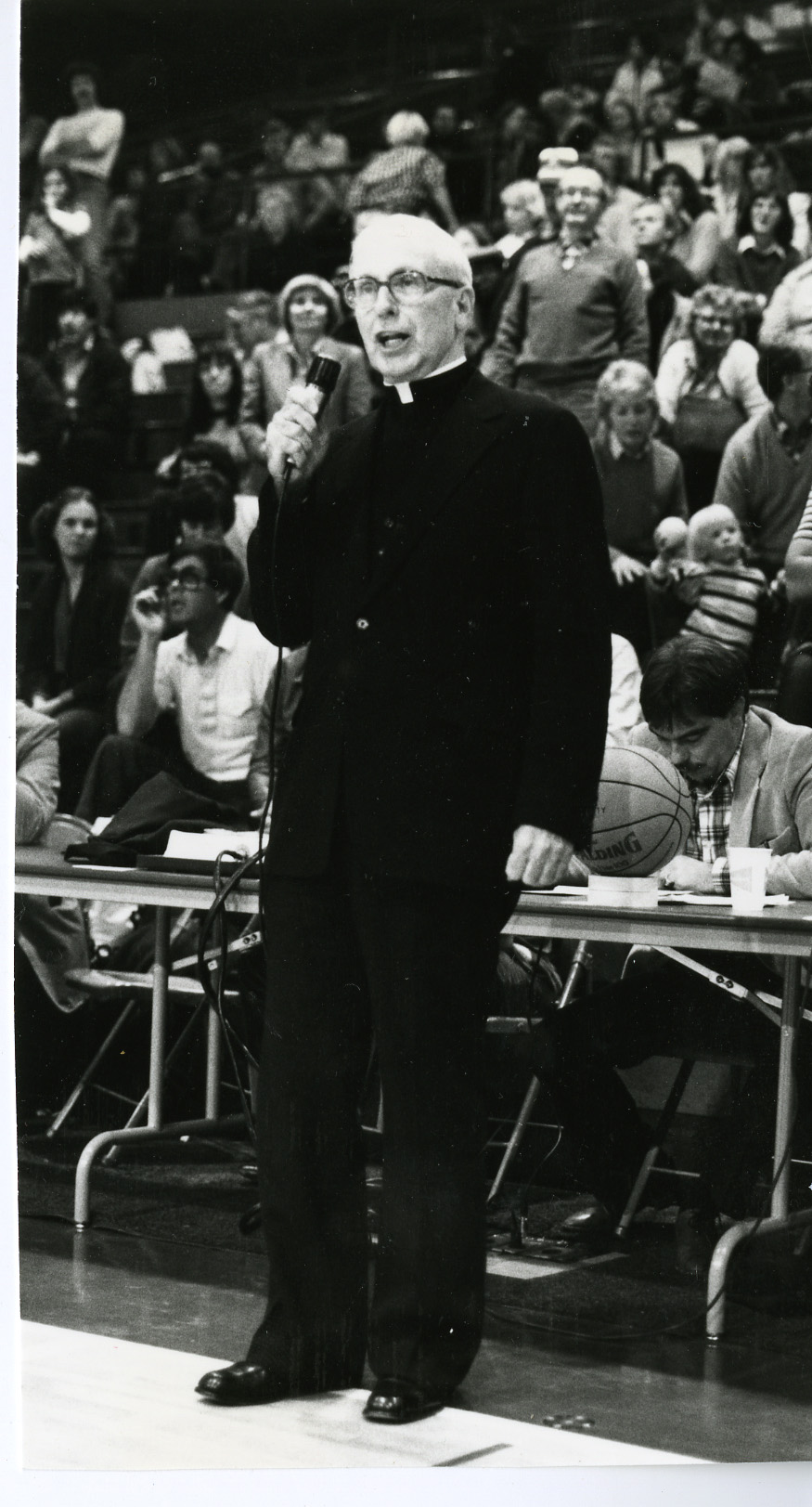
The Rev. John. T. Richardson, C.M., at his desk, Fall 1963. (Photo courtesy of the Chicago Tribune)

The Rev. John. T. Richardson, C.M., speaking at his inauguration in 1981. (DePaul University)

The Rev. John. T. Richardson, C.M. (center) and the Rev. Dennis H. Holtschneider, C.M. (left) at the inauguration ceremony of A. Gabriel Esteban, Ph.D. (right), president of DePaul University, on Nov. 19, 2017. (DePaul University/Jamie Moncrief)
This article was edited on March 30 to reflect updated service information.
The Rev. John T. Richardson, C.M., a visionary who led the historic expansion of DePaul University during his 12-year presidency, has died. He passed away March 29 at age 98 at the Apostle of Charity residence at St. Mary’s of the Barrens in Perryville, Mo., where he lived in recent years. He served as president of DePaul University from 1981-93 and chancellor from 1993-2017.
“Fr. Richardson’s leadership of DePaul resulted in growing our national reputation, while expanding our engagement in the city of Chicago and deepening our commitment to the university’s Catholic, Vincentian, and urban mission,” says DePaul President A. Gabriel Esteban. “He was a visionary leader, whose impact on our university will endure, and he will be missed by all in the DePaul family.”
During his tenure of more than half a century at DePaul, Richardson’s focus remained steadfast on the university’s mission to provide a quality education to students of all backgrounds, including low-income and first-generation students, raising the university’s academic stature and strengthening DePaul’s impact throughout Chicago and the world. His presidency marked a period of intense growth of DePaul's community involvement in Lincoln Park, the Loop and all of Chicago. Hallmarks of his time with the university include increasing the DePaul’s appeal to students across the country, strengthening the university’s Vincentian commitment to its urban community and developing the diversity of faculty, staff and the student body.
Early years at DePaul University
Richardson joined DePaul in 1954 as dean of the Graduate School where he oversaw the university’s graduate programs. In this position, he emphasized collegiality and academic excellence, as well as an environment of trust and support for faculty and administrators. It was during this time he first began to envision DePaul as a long-term home.
 The Rev. John T. Richardson, C.M., served as president of DePaul University from 1981-93 and chancellor from 1993-2017. (DePaul University/Jamie Moncrief)
The Rev. John T. Richardson, C.M., served as president of DePaul University from 1981-93 and chancellor from 1993-2017. (DePaul University/Jamie Moncrief)Soon after he began his tenure at DePaul, Richardson was appointed to the Board of Trustees in 1954, a position he held until he reached mandatory retirement age in 1995. In his memoirs, Richardson called his early years on the board “invaluable” to learning the complex operations of DePaul.
From 1955-70, Richardson taught jurisprudence in the College of Law. Among his students was the future Chicago mayor, Richard M. Daley, and dozens of future Cook County judges.
DePaul named Richardson executive vice president and dean of faculties in 1960, holding the former post for 20 years and the latter for 21 years. As executive vice president, he served as the principal advisor to the president. As dean, he established three new schools: The School for New Learning, now the School of Continuing and Professional Studies; the School of Education, now the College of Education; and The Theatre School, which was originally the nationally renowned Goodman School of Drama. In addition to restructuring and modernizing the undergraduate curriculum, he also instituted the university’s first doctoral programs in education, computer science, philosophy and psychology. Upon his appointment as president, Richardson combined the executive vice president and dean of faculties posts under the title of provost.
During this time, he worked closely with the university’s president, the Rev. John R. Cortelyou, C.M., to update university governance leading to the establishment in 1967 of a restructured Board of Trustees with full powers to govern the university, and comprised largely of lay men and women.
Putting ‘invaluable’ experience to work as president
Richardson was elected DePaul’s president by the Board of Trustees and assumed the office in 1981 when the Rev. John R. Cortelyou, C.M., stepped down after 17 years of service. Richardson said of his tenure, "I would see the era of the ‘60s and ‘70s where DePaul moved very fast in becoming a true university … I would see the ‘80s and ‘90s as looking more at our mission."
He led the university’s unprecedented $100 million Cornerstone Campaign from the late 1980s to the early 1990s, which led to major expansions of DePaul’s Loop and Lincoln Park campuses. Enrollment at DePaul jumped dramatically during his tenure and the school again became the largest Catholic university in the nation. By the end of Richardson's presidency, enrollment had reached 16,500. Enrollment increases during his tenure were driven in part by the construction of three new residence halls in Lincoln Park, which dramatically changed life at DePaul as the university began to attract students from out of state.
During his presidency, DePaul’s commitment to Chicago and expanding its physical footprint within the city increased significantly. Examples of DePaul's urban expansion can be found in the 1150 W. Fullerton Ave. building, which DePaul bought and renovated in 1993; the purchase of the Blackstone Theatre, renamed the Merle Reskin Theatre, on Balbo Ave. and Wabash Ave. in 1989; and the purchase of Goldblatt’s department store, now known as the DePaul Center, at the corner of State St. and Jackson Blvd. in 1991, for the relatively small sum at the time of $1 million. DePaul modernized the building and then leased five floors back to the city. Both projects allowed for new programs to be established at the university and brought thousands of students and patrons back to the area in a move that helped kick start the revitalization of the South Loop.
In 1992, DePaul began construction on the university’s first free-standing library on the Lincoln Park Campus, made possible by a major donation from the family of DePaul alumnus Richard Heise. Little did Richardson know, the family requested the new library be named in his honor: The John T. Richardson Library. In his memoirs, he notes having his name on the library was “one of the greatest honors I’ve ever received.”
Richardson also recognized the important responsibility DePaul had as Chicago’s university. He took it upon himself to meet with top executives to build relationships and let them know what DePaul had to offer — smart, diverse and urban educated talent for their workforces. DePaul also committed to creating a $2.5 million scholarship program for Chicago students who perform community service and formed partnerships with 47 inner-city schools.
Under Richardson's direction, DePaul established the International Human Rights Law Institute, the Institute for Business Ethics, the Center for Church/State Studies and the Center for Urban Education.
He humbly credited his “intelligent and innovative” colleagues and advisors for contributing to his success at DePaul.
Finding health and adventure outside the office
Richardson’s lifestyle way very simple and unpretentious. He lived with other priests in the Vincentian residence and refused any special considerations as president. He was extremely grateful for his good health during this time. He exercised regularly and paid it forward by donating blood when he could. He said, “After 100 donations, I stopped counting.”
 The Rev. John T. Richardson, C.M., speaking at a DePaul basketball game in an undated photo. (DePaul University)
The Rev. John T. Richardson, C.M., speaking at a DePaul basketball game in an undated photo. (DePaul University)Every Saturday, he walked from Lincoln Park to his office in the Loop to get some work done, free of distractions and phone calls. The weekly trek was roughly three miles one-way and he credited those long walks to helping maintain his good health.
Upon his retirement as president in 1993, Richardson continued to live in the Vincentian residence on campus and assumed the title of chancellor. He wanted to continue using his time and talents for the university and did so by remaining involved in fundraising, advising the president and working closely with his colleagues in public relations and development.
By 1997, Richardson had been at DePaul for 43 years and his adventurous spirit was searching for a new chapter. Inspired by stories from his brother, Jim, and fellow Vincentians about their work in Africa, he volunteered to teach as part of the Vincentian mission in Nyeri, Kenya.
At Christ the King Seminary in Kenya, Richardson taught seminarian courses ranging from English composition and anthropology to sociology and comparative religion. At one point, he was teaching seven of the eight courses offered in the seminary. In many cases, though, Richardson had no textbook on which to base his courses. As a result, he spent much of his time and energy creating his own. When he returned to the U.S., friends encouraged him to print his textbooks, which turned into “Readings in Catholic Social Teaching.” He completed and published the book in February 2015.
“I left with the feeling that my experience in Kenya had made me a better priest and a better person,” Richardson expressed in his memoir.
Upon his return to DePaul in 2010, he was welcomed with open arms by then-president, the Rev. Dennis H. Holtschneider, C.M., who asked him to return to his work as chancellor. Richardson graciously accepted, as he felt he “still had something to offer the university.” In his role, he was able to pick up where his presidency left off, traveling the country and securing significant contributions to the university through donor gifts. Many of the gifts went toward the “Many Dreams. One Mission” fundraising campaign, which completed in 2014 and exceeded its goal of $250 million.
Early years and community accomplishments
Richardson was born in Dallas, Texas, to Patrick and Mary Walsh Richardson on Dec. 20, 1923. He was the youngest of nine children.
He joined the Congregation of the Mission (the Vincentians), the religious community that founded and sponsors DePaul University, in 1942. He earned his bachelor’s degree in philosophy from St. Mary's Seminary in Perryville, Mo., in 1946. Ordained to the priesthood in 1949, he received licentiate and doctoral degrees in sacred theology from the Angelicum University in Rome in 1950 and 1951, respectively. In 1954, he received a master's degree in sociology from St. Louis University.
In his spare time, Richardson generously donated his expertise and leadership to many organizations in his community including the Greater State Street Council, Commercial Club, Children’s Memorial Hospital, Lincoln Park Zoo and the Loop Community Junior College, to name a few. He was a member of many international commissions for the Congregation of the Mission, and served as chairman of the Federation of Independent Illinois Colleges and Universities. He was also a board member of Tangaza College in Nairobi, Kenya.
In 1994, former Illinois Gov. Jim Edgar recognized Richardson for his local, national and global contributions and inducted him as a Laureate in the Order of Lincoln. It is the highest honor bestowed by the State of Illinois.
Richardson joins his parents and siblings in heaven, including his brother, the Rev. James Richardson, C.M., formerly Superior General of the Congregation of the Mission.
On April 4, a reception of the remains will be held at 5 p.m. at Apostle of Charity Residence, Mother of God Chapel at 1701 W. Saint Joseph St., Perryville, Mo. A wake and vigil service will follow at 7 p.m. On April 5, a funeral Mass will be celebrated at 10:30 a.m. at the Mother of God Chapel followed by the Rite of Committal in the Vincentian Community Cemetery. The services will be livestreamed on
St. Mary’s of the Barrens’ Facebook page. Services at St. Vincent de Paul Parish at 1010 W. Webster Ave. are pending.
Memorial donations may be made to benefit the work of the
Congregation of the Mission; click “Donate” on the home page. Memorial gifts may be allocated for care of senior Vincentian priests and brothers, the Kenya mission, DePaul University, and more.